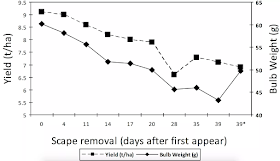If you haven’t signed up for it before, OMAFRA has a fantastic vegetable blog. A couple of years ago, Travis Cranmer, OMAFRA’s Allium Specialist, wrote a great piece about the benefits of removing garlic scapes.
 |
| Figure 1. Yield and bulb weight in response to scape removal timing of garlic cv. ‘Music’. (Zandstra, 2006) |
 |
| Figure 2. Influence of leaf removal on yields and bulb weights of garlic cv ‘Music’. (Zandstra, 2000) |
Scape removal is also a good time to be on the lookout for leek moth damage in your crop. Leek moth is a new pest to Nova Scotia and has been found in Kings and Annapolis Counties. Cornell has an excellent site devoted to providing further leek moth information. If you grow garlic, leeks, or onions, I strongly suggest you make yourself familiar with this pest.
 |
| Leek moth damage on garlic, photo credit Amy Ivy, Cornell |
 |
| Leek moth damage on garlic scapes, photo Scott Lewins, UVM |

